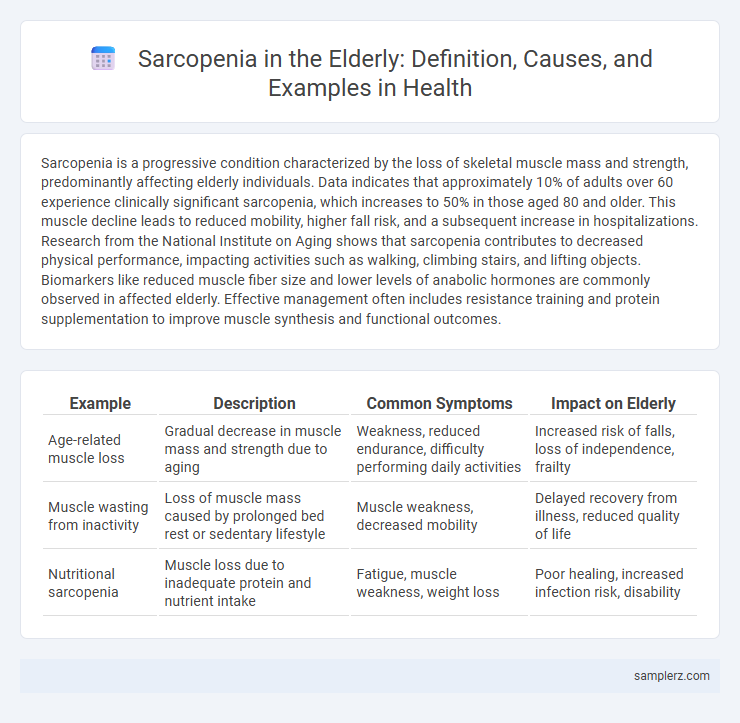Sarcopenia is a progressive condition characterized by the loss of skeletal muscle mass and strength, predominantly affecting elderly individuals. Data indicates that approximately 10% of adults over 60 experience clinically significant sarcopenia, which increases to 50% in those aged 80 and older. This muscle decline leads to reduced mobility, higher fall risk, and a subsequent increase in hospitalizations. Research from the National Institute on Aging shows that sarcopenia contributes to decreased physical performance, impacting activities such as walking, climbing stairs, and lifting objects. Biomarkers like reduced muscle fiber size and lower levels of anabolic hormones are commonly observed in affected elderly. Effective management often includes resistance training and protein supplementation to improve muscle synthesis and functional outcomes.
Table of Comparison
| Example | Description | Common Symptoms | Impact on Elderly |
|---|---|---|---|
| Age-related muscle loss | Gradual decrease in muscle mass and strength due to aging | Weakness, reduced endurance, difficulty performing daily activities | Increased risk of falls, loss of independence, frailty |
| Muscle wasting from inactivity | Loss of muscle mass caused by prolonged bed rest or sedentary lifestyle | Muscle weakness, decreased mobility | Delayed recovery from illness, reduced quality of life |
| Nutritional sarcopenia | Muscle loss due to inadequate protein and nutrient intake | Fatigue, muscle weakness, weight loss | Poor healing, increased infection risk, disability |
Common Signs of Sarcopenia in Older Adults
Common signs of sarcopenia in older adults include noticeable muscle weakness, decreased muscle mass, and slower walking speed, which often contribute to reduced physical performance and higher risk of falls. Elderly individuals may also experience difficulty rising from a chair, climbing stairs, and reduced grip strength due to muscle atrophy. Early identification of these signs is crucial for implementing resistance training and nutritional strategies to improve muscle function and overall quality of life.
Real-Life Case Studies: Sarcopenia in the Elderly
An 82-year-old woman experienced significant muscle loss and reduced mobility due to sarcopenia, leading to frequent falls and difficulty performing daily activities. Real-life case studies highlight that elderly patients with sarcopenia often present with decreased muscle mass measured by DXA scans and impaired grip strength, contributing to increased frailty and higher risk of hospitalization. Interventions such as resistance training combined with protein supplementation have demonstrated improvements in muscle strength and physical function in this population.
Functional Limitations Caused by Sarcopenia
Sarcopenia in elderly individuals leads to significant functional limitations, including decreased muscle strength, impaired balance, and reduced mobility. These impairments increase the risk of falls, fracture, and loss of independence in daily activities such as walking, climbing stairs, and rising from a chair. Early identification and targeted interventions like resistance training and nutritional support can help mitigate these functional declines.
Daily Challenges Faced Due to Muscle Loss in Seniors
Sarcopenia in elderly individuals leads to significant daily challenges, including decreased muscle strength impacting balance and increasing fall risk. Seniors often struggle with routine activities such as climbing stairs, carrying groceries, or rising from a chair due to muscle deterioration. This muscle loss also contributes to reduced mobility, loss of independence, and greater vulnerability to injuries and fractures.
Typical Progression of Sarcopenia with Age
Sarcopenia typically begins with a gradual decline in muscle mass and strength after age 50, accelerating markedly after age 70. Elderly individuals often experience reduced muscle fiber size, decreased motor unit numbers, and impaired mitochondrial function, leading to physical frailty and increased risk of falls. This progressive muscle deterioration results in decreased mobility, loss of independence, and higher incidence of chronic health conditions such as osteoporosis and metabolic disorders.
Impact of Sarcopenia on Mobility and Independence
Sarcopenia significantly reduces muscle mass and strength in elderly individuals, leading to impaired mobility and increased risk of falls. This decline compromises independence, making routine activities such as walking, climbing stairs, and carrying objects increasingly difficult. Early intervention through resistance training and nutritional support can help mitigate these mobility challenges and enhance quality of life.
Nutritional Factors Linked to Elderly Sarcopenia
In elderly individuals, insufficient protein intake significantly contributes to the development of sarcopenia by impairing muscle protein synthesis and accelerating muscle mass loss. Deficiencies in essential micronutrients such as vitamin D and omega-3 fatty acids further exacerbate muscle weakness and functional decline associated with sarcopenia. Optimal nutritional strategies emphasizing adequate protein consumption, along with supplementation of key vitamins and fatty acids, are critical for mitigating sarcopenia progression in aging populations.
Physical Activity Examples for Preventing Sarcopenia
Engaging in resistance training exercises such as weight lifting and bodyweight movements like squats and lunges effectively combats sarcopenia in the elderly by stimulating muscle growth and strength. Incorporating aerobic activities like brisk walking, swimming, or cycling enhances cardiovascular health while maintaining muscle endurance essential for daily functioning. Balance and flexibility exercises, including yoga and tai chi, reduce fall risk and improve mobility, complementing overall sarcopenia prevention strategies.
Medical Conditions Associated with Sarcopenia in Seniors
Sarcopenia in elderly individuals is frequently associated with medical conditions such as osteoporosis, type 2 diabetes, and chronic obstructive pulmonary disease (COPD), which exacerbate muscle loss and functional decline. Cardiovascular diseases and insulin resistance also contribute to accelerated muscle degradation, worsening mobility and increasing fall risk. Understanding the interplay between sarcopenia and these comorbidities is crucial for developing targeted interventions to preserve muscle mass and improve quality of life in seniors.
Success Stories: Elderly Overcoming Sarcopenia
Elderly individuals like 78-year-old Margaret have successfully reversed sarcopenia through personalized resistance training and protein-rich nutrition, resulting in improved muscle mass and mobility. Clinical studies reveal that consistent physical therapy combined with dietary adjustments enhances muscle strength by up to 30% in sarcopenic patients over 65. These success stories underscore the effectiveness of integrated exercise and nutrition programs in combating age-related muscle loss and improving quality of life for seniors.

example of sarcopenia in elderly Infographic
 samplerz.com
samplerz.com